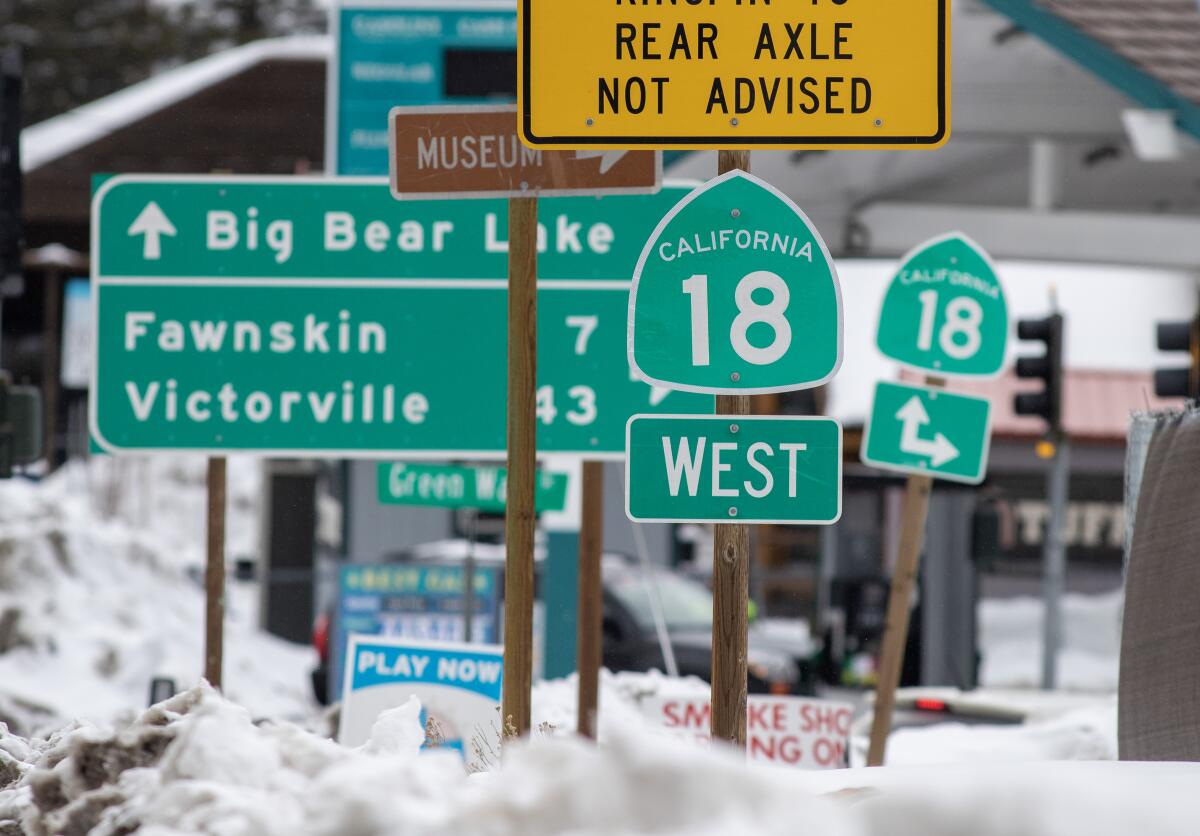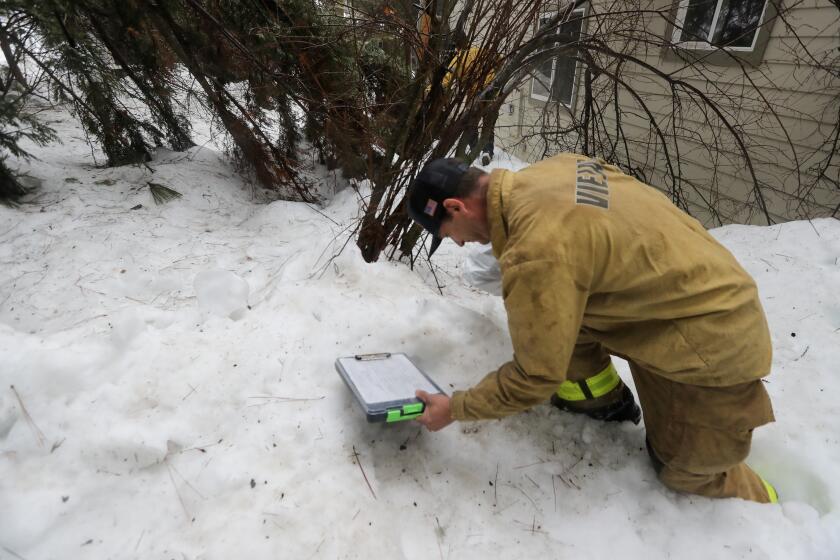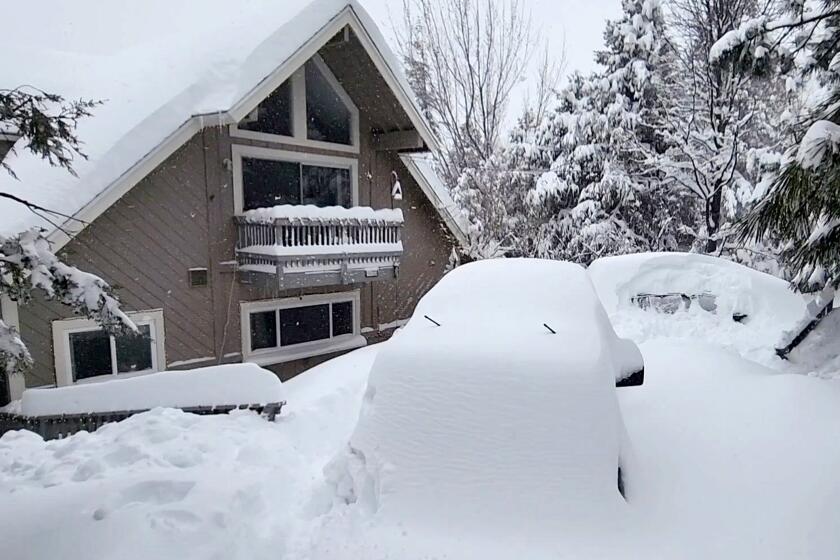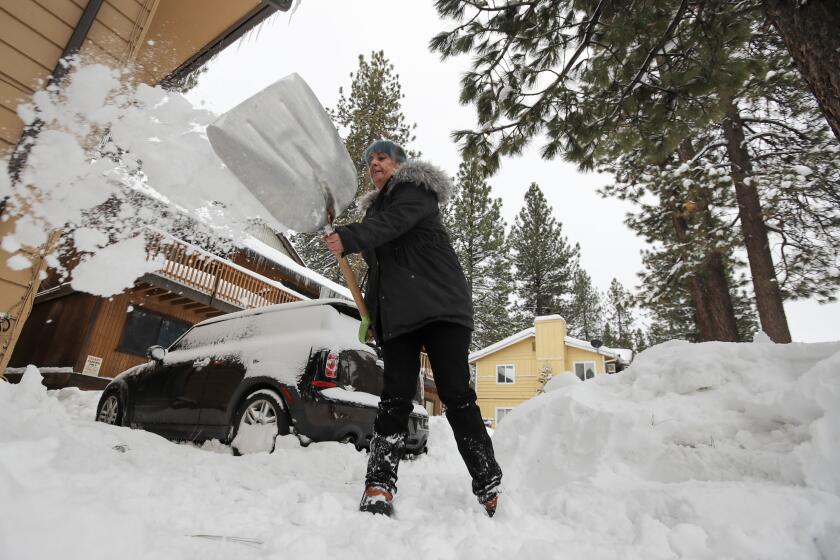From Tahoe to Yosemite to Arrowhead, heavy snow buries California mountain communities

- Share via
Another week of pounding snow has deluged many of California’s most popular mountain resorts and communities, from Lake Tahoe to Lake Arrowhead, where residents struggled with shuttered highways and dwindling food supplies.
Crews across the state worked desperately to clear roadways as more snow fell overnight amid a blizzard warning that had been in place since Monday. Record-breaking snowfall forced Yosemite National Park to close, and emergency officials pleaded with people to stay home and avoid the roads. The deteriorating situation spurred Gov. Gavin Newsom to declare a state of emergency in 13 counties.
The Sierra was particularly hard hit, with all the major roads to Lake Tahoe closed and reports of at least one 200-yard-wide avalanche.
Some had no choice but to stay put.
Many residents remained trapped in their homes in the San Bernardino Mountains on Wednesday as crews worked to clear roads of snow that had blanketed the area in recent days, leading to at least one report of a collapsed roof and hampering the emergency response to a structure fire that injured two people.
Crews from the California Department of Transportation had planned to escort residents over mountain highways that have been closed since Friday, but those plans were suspended Wednesday morning because drivers continued to get stuck in the snow even with chains on their tires.
Workers were racing to clear the highways for residents in the Lake Arrowhead, Crestline and Running Springs communities, according to county officials.
“We understand the nature of this emergency and how it is impacting our residents,” San Bernardino County Supervisor Dawn Rowe said during a news conference Wednesday. “We know we have stranded residents. It is our No. 1 priority to get to those residents so that they can have the safe environment that we hope to provide to them.”
California’s deadly storm season continued Friday as the first of two atmospheric river storms descended on the state, prompting evacuation orders.
Late Wednesday, Gov. Newsom declared a state of emergency in 13 counties — Amador, Kern, Los Angeles, Madera, Mariposa, Mono, Nevada, San Bernardino, San Luis Obispo, Santa Barbara, Sierra, Sonoma and Tulare. The governor also activated the California National Guard to help in storm response efforts, including in San Bernardino County, where Guard members and personnel from the California Department of Forestry and Fire Protection were set to “go door to door” to help rescue people trapped in their homes.
In the community of Blue Jay, about a mile from Lake Arrowhead Village, a structure fire injured two people, according to the San Bernardino County Fire Department. The structure was “fully involved to the ground” and only accessible by snow cat, the department said on Twitter, noting firefighters had to dig through snow to get to the hydrant.
Lake Arrowhead has received 2.5 feet of snow in the last 48 hours, according to the National Weather Service, and the surrounding area has seen over 6 feet of snow in the last week.
Goodwin’s Market in Crestline was closed Wednesday after the additional snowfall overnight collapsed part of its roof.
“We know many of you are counting on us and we will do everything we can to get open as soon as possible,” the market said in a Facebook post.
Rowe acknowledged that the risk to structures was also a concern for the county heading into the sixth day of snowfall. Mounds of snow reached rooftops in the mountain communities and made it nearly impossible to get around by car or on foot.
Caltrans maintenance crews are working to clear roads for stranded residents before another storm hits Tuesday.
“We hear you. We know that you are concerned and we know that this is changing with the additional snow that fell last night,” Rowe said.
Snowplow drivers were expected to be clearing the roads for the next week, Rowe said.
Some residents posted videos on social media of their journeys up the mountain highways with escorts from Caltrans before they were put on pause.
Many more are trapped in their homes.
Gov. Gavin Newsom declared a state of emergency Wednesday for 13 counties in California that have been hammered by historic winter storms.
Brooke Cutler and her family spent most of Tuesday digging their way out of the snow at their home in Lake Arrowhead.
A plow had cleared the paved and dirt roads in her neighborhood overnight. Large mounds of snow were piled up outside her home, but by the time Cutler and her family dug their way out, the roads were covered by snow again.
The plows “had just gotten to the neighborhood roads and did a good job of clearing them,” Cutler said. “We had to shovel out our cars, and by the time we had shoveled them out it was dark and the snow started again.”
Cutler figured that if a few inches fell overnight, she could dig herself out in the morning with her family.
“It ended up being 1 to 2 feet. So, we’re stuck again,” Cutler said. “We imagine the plows are starting over on the cycle again to clear the other roads.”
San Bernardino County officials were overwhelmed by the snowfall and the task of clearing snow-covered roads.
“That’s too much for local resources to keep up with,” said Brendon Biggs, director of Public Works in San Bernardino County. “So, a lot of primaries and secondaries and state highways were buried, and so we are in the process of digging them out right now.”
Officials also responded to nearly 100 rescue calls because of the snow, according to San Bernardino County Fire Chief Dan Munsey.
He urged anyone who has warm shelter and food to stay in their homes, adding that emergency officials would be prioritizing their calls for emergency services.
“In San Bernardino, as beautiful as it is and as beautiful as our geography is, we do need to have some level of self-sufficiency,” Munsey said.
Farther north, rangers at Yosemite National Park estimated up to 15 feet of snow had fallen at the higher elevations of the world-famous park. Snow reached up to the second floor of the Badger Pass ski lodge.
The snowfall broke a 54-year daily record by more than a few inches. Experts said this year could bring record snowfall for many other parts of California.
“In all of my years here, this is the most snow that I’ve ever seen at one time,” said Scott Gediman, a spokesperson for Yosemite and ranger for 27 years. “This is the most any of us have ever seen.”
The park was closed Wednesday as rangers and park staff dug their way out of up to 40 inches of snow that fell overnight in Yosemite Valley, among the park’s lowest elevations. The previous record for Feb. 28 snow accumulation on the valley floor had been set at 36 inches in 1969.
The park’s ski area hadn’t had decent snowpack for the last five years or so because of the drought, Gediman said, but as of Wednesday, snow reached up to some of the chair lifts and the second floor of the lodge.
Officials originally planned to temporarily close the park ahead of the severe winter weather last week, but with additional snow falling through Wednesday, a planned reopening has been indefinitely postponed.
“What we’re doing is literally taking it one day at a time,” Gediman said, unable to give an estimate for reopening. “We’re just digging out and doing the best we can to remove the snow and get the park ready for visitors in a safe manner.”
A blizzard warning for the entire Sierra Nevada was in effect through 4 p.m. Wednesday, following days of extreme conditions. Up to 6 additional feet of snow were possible from this week’s storm, as well as wind gusts up to 75 mph, the warning said.
Blizzard conditions shut down most major highways and roads in the Greater Lake Tahoe area, including Interstate 80 and Highway 50. California Highway Patrol pleaded with drivers to not attempt to cross over Donner Summit on I-80.
“Officers have been responding to stuck motorists all day,” the CHP Truckee division wrote in a social media post. “Travel conditions are extremely dangerous with zero visibility and blizzard conditions.”
Mono County Sheriff’s Office warned drivers in a Facebook post Tuesday that all roads in the snow-inundated area were closed. “There is no alternate route, back way, or secret route. It’s a blizzard, people. You cannot see your hand in front of your face, let alone a snow stake to guide your way. Stay home,” the post said.
On Tuesday at about 7 p.m., an avalanche, measuring 200 yards wide and 25 feet deep, struck a three-story apartment building in Olympic Valley, according to the Placer County Sheriff’s Office. Everyone inside was evacuated, and no one was injured.
Because of the increased avalanche risk, other areas in Olympic Valley were evacuated, including neighborhoods from Shirley Canyon Road to Granite Chief Road, Sandy Way from Wayne Road to Navajo Court, and between Summit Peak Road and Summer Place, according to the sheriff’s office.
Carl Bass, who splits his time living in Berkeley and Olympic Valley, said his son, Willie Bass, was in their house in Olympic Valley in the evacuation zone.
“We owned the house for about 20 years, so there’s always a risk of avalanche, but we haven’t seen any,” Bass said. “This storm was unusual. It was just a huge amount of super-light, super-dry powder. I looked and there was almost 4 feet of snow over the past 24 hours.”
Even in urban Southern California, the storm brought hail and graupel to many communities and plunging snow levels to 1,000 feet in some areas.
It was a day of rain, sunshine and then icy downpours, which affected the South Bay, Long Beach, Disneyland and many valley and foothill communities. The National Weather Service’s Los Angeles office reported a graupel shower in Malibu, about 540 feet above sea level.
More to Read
Sign up for Essential California
The most important California stories and recommendations in your inbox every morning.
You may occasionally receive promotional content from the Los Angeles Times.















